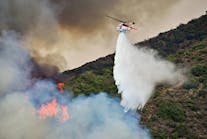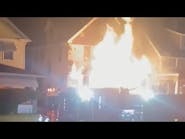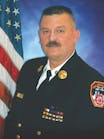I can remember my dad driving me to Los Angeles International Airport, where we watched these monsters roar down the runway, feeling the vibration from their engines through my feet and watching them soar into the sky, wondering where they were going.
Today, I still marvel at these huge beauties as they again fill the sky but mostly during the summer months. That's when brushfires burn in Southern California.
On Monday, Aug. 26, 1996, a brushfire was reported at Castaic in the northern end of Los Angeles County. I spent the entire day on the fire lines and watched as the flames ripped through thousands of acres of prime forest land. Calls went out for numerous strike teams of engines and camp crews and all available aircraft. That evening I made up my mind to go to Fox Air Tanker Base the following morning, as I knew more tankers would be brought in to fight this huge blaze, which destroyed over 10,000 acres in its first 12 hours.
Fox Air Tanker Base is about 50 miles northeast of Los Angeles in the city of Lancaster, near Edwards Air Force Base, and is located at the east end of Fox Field, a public airport. I arrived around noon and met with two U.S. Forest Service representatives, Clay Myers and Rosie Massiet, who were busy in the tower. The tanker base was alive with activity as tankers were arriving, loading and taking off every few minutes. Additional tankers were enroute from other bases in the state. The fire was more than 40 miles from the tanker base but a huge column of smoke that rose 10,000 feet into the sky was visible. By the color of the smoke, it was apparent there had been a blow-up on the fire line.
At the same time, another blaze was burning in the forest above Azusa in San Gabriel Canyon; it had burned 1,400 acres but was being contained. Tankers that had been working the Azusa fire were being diverted to the new, more dangerous blaze in Castaic.
Tanker bases vary in their size and in the number of tankers based at each. Fox Air Tanker Base has two DC-4s on stand-by at all times. At Fox, up to four tankers ranging in size from small twin-engine planes to huge four-engine "heavies" can be loaded with retardant at the same time. Off the apron are two huge tanks, each loaded with 40,000 gallons of a pre-mixed fire retardant. This sticky, gooey, chemical fertilizer is pumped underground from the tanks to the four aprons. Next to the tanks is a semi-trailer loaded with 40,000 pounds of powdered retardant ready to be automatically mixed with water and pumped into the tanks as they get low. The 40,000 pounds of retardant, when mixed, will make 36,000 gallons. Additional powdered retardant can be ordered as needed, based on the size of the fire.
At each loading area is an empty 2,000-gallon tank. These are used to quickly off-load a plane in case a problem arises. A ground crew of 10 to 12 people positions the planes for loading, fills the planes, then washes down the apron of spilled retardant after the aircraft pulls away.
The twin-engine aircraft used by the Forest Service are the Grumman S-2, P2V and SP2H. The S-2 carries between 800 to 1,000 gallons of retardant. The P2V can carry up to 2,450 gallons because it is jet assisted and the SP2H carries up to 2,000 gallons. The S-2s belong to the California Department of Forestry (CDF) and were brought in from all over the state to help with this fire.
The four-engine heavies are the Douglas DC-4, DC-6 and DC-7. Former military aircraft include the C-130, P-3, P2-V, PB4Y-2 and the SP2H. The heavies each can carry from 2,000 to 3,000 gallons of retardant. The pilots have the final say on how much they will carry and whether they will even fly. Factors that weigh on that decision include:
Weather. Normally, very hot weather brings an onslaught of brushfires. The big planes will labor more if the weather is hot; therefore, the pilot can have the weight of the load reduced. Winds play havoc with a tanker. Santa Ana Winds or the thermal updraft from the fire itself can toss the plane around.
Visibility. Smoke from the fire sometimes can reduce the visibility at the fireground to zero. If the pilot thinks any of these conditions are extreme, he can choose not to fly.
Most heavies have four to eight doors, which means they can make up to eight separate drops with one load but most of the time the drops will be from one (a "salvo") to four.
At the fire scene the entire operation is under the command of the air attack supervisor, who coordinates with ground forces and is in charge of all air operations. That person flies a twin-engine Aero Commander and is always over the drop zone. Below is the lead plane, a Beech Baron, that leads a tanker in over the spot where the drop will be made. Before the drop is made, however, the lead plane makes a dry run over the drop area to check for any problems high-tension lines or wind, for example and formulate an escape route in case of a problem. This dry run also alerts ground crews that a drop can be expected on the next run, known as the "live run." A load of retardant is not light and could cause injuries if not expected a DC-6 carries 2,450 gallons weighing 27,500 pounds. The lead plane then goes up to meet the tanker and lead it in. Sometimes, if a long line of retardant has to be laid down, two, three or even four tankers at a time will follow the lead plane.
The retardant is not designed to put out the flames. Rather, it is laid down yards in front of the advancing flames and is designed to slow the fire. During a Santa Ana wind condition, dropping on the head of the fire is out of the question due to spotting; then, the tankers make drops on the flanks or can be used to protect a structure. If the fire is beyond the means of the tankers available, additional aircraft can be ordered in from anywhere in the country.
Wondering about the cost of flying the planes? Here's where the cost of firefighting goes up dramatically. While on standby, the DC-4s, DC-6s and DC-7s cost $1,900 per day. While flying, the same planes cost $1,200 per hour. Think that's bad? A P-3 costs close to $2,400 an hour and the C-130 times out at around $3,000 an hour. Retardant can cost from $690 for the smaller S-2s to close to $2,500 per load for the C-130 and P-3. Tanker pilots can fly a maximum seven hours a day in S-2s and eight hours a day aboard the heavies.
Air tanker bases are by no means fixed. A mobile tanker base can be set up anywhere there is adequate runway space and a water supply. Fox Air Tanker Base has 2,000-pound packs of powdered retardant that can be trailered anywhere a base needs to be set up in a matter of hours.
The pilots who fly the heavies are contracted. The planes are owned by private companies and leased or rented to the Forest Service but the pilots contract to spend a certain amount of time at designated tanker bases. The pilots have their own mechanics and no matter where the planes go, the mechanics follow the planes are between 25 and 40 years old and need constant care.
The next time you see one of these "heavies" working a fire, appreciate the work that goes into keeping them in the air. They can make the difference of whether a fire is held to a few acres or blows up and destroys thousands.
I would like to thank Clay Myers and Rosie Massiet of the U.S. Forest Service at Fox Air Tanker Base for their assistance in this story.
Mike Meadows is a California-based freelance writer and photographer with an interest in the fire service.








